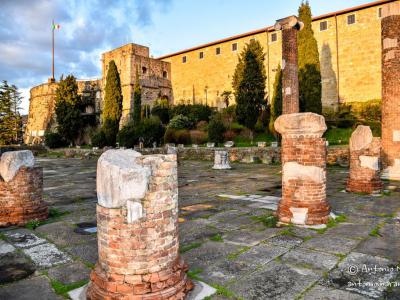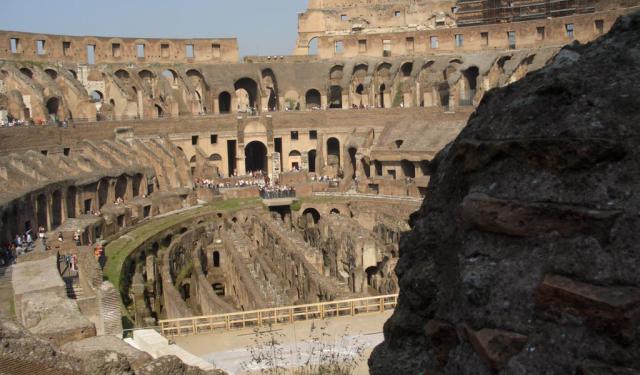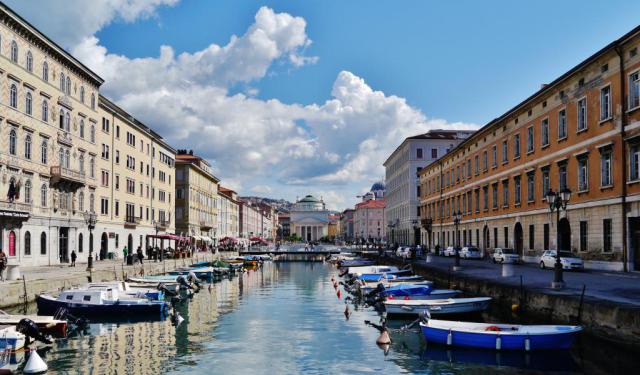
Propylaeum and Roman Basilica, Trieste
The word "propylaeum" is derived from the old Greek word "propylaion," meaning literally "gateway to higher culture." In Ancient Greece and Rome, a propylaeum would usually take the form of a portico supported by columns inside and outside the actual gateway.
In pre-Christian Rome, basilicas were mostly used as public buildings. They served as law courts, financial centers, drill halls, and reception centers. Basilicas usually had apses, a semi-circular shape off the short wall of the building. The law court would be in the apse. The rest of the basilica was an audience hall.
From these forms evolved the early Christian basilicas, often keeping some elements of propylaeum. The ancient Roman buildings of Trieste are concentrated on top of San Giusto Hill. The Catholic Cathedral of Trieste was built in 1320 on the site of a 6th-century Roman Propylaeum. The remains are absorbed in the bell towers of the cathedral.
The old stairway of the propylaeum is still visible. The lapidary garden of archeologist Domenico Rossetti dates from the 19th century. There are epigraphs, monuments, and sculptures of Roman and Medieval times.
Excavations of the early 20th century uncovered bits of the old civil basilica. It had three naves. Close to the basilica is what remains of the Forum of Roman Trieste.
In pre-Christian Rome, basilicas were mostly used as public buildings. They served as law courts, financial centers, drill halls, and reception centers. Basilicas usually had apses, a semi-circular shape off the short wall of the building. The law court would be in the apse. The rest of the basilica was an audience hall.
From these forms evolved the early Christian basilicas, often keeping some elements of propylaeum. The ancient Roman buildings of Trieste are concentrated on top of San Giusto Hill. The Catholic Cathedral of Trieste was built in 1320 on the site of a 6th-century Roman Propylaeum. The remains are absorbed in the bell towers of the cathedral.
The old stairway of the propylaeum is still visible. The lapidary garden of archeologist Domenico Rossetti dates from the 19th century. There are epigraphs, monuments, and sculptures of Roman and Medieval times.
Excavations of the early 20th century uncovered bits of the old civil basilica. It had three naves. Close to the basilica is what remains of the Forum of Roman Trieste.
Want to visit this sight? Check out these Self-Guided Walking Tours in Trieste. Alternatively, you can download the mobile app "GPSmyCity: Walks in 1K+ Cities" from Apple App Store or Google Play Store. The app turns your mobile device to a personal tour guide and it works offline, so no data plan is needed when traveling abroad.
Propylaeum and Roman Basilica on Map
Sight Name: Propylaeum and Roman Basilica
Sight Location: Trieste, Italy (See walking tours in Trieste)
Sight Type: Attraction/Landmark
Guide(s) Containing This Sight:
Sight Location: Trieste, Italy (See walking tours in Trieste)
Sight Type: Attraction/Landmark
Guide(s) Containing This Sight:
Walking Tours in Trieste, Italy
Create Your Own Walk in Trieste
Creating your own self-guided walk in Trieste is easy and fun. Choose the city attractions that you want to see and a walk route map will be created just for you. You can even set your hotel as the start point of the walk.
Trieste's Ancient Roman Sites Walking Tour
The Roman remains on Trieste extend along the northwestern slope of San Giusto Hill, overlooking the Gulf of Trieste. Wharves of sandstone slabs dating from the 1st century AD were found by the Roman Theatre. The city walls, ordered by Augustus, were converted to use as terraces.
The Propylaeum of the 1st century AD was the gateway to the sacred area of the Capitoline Temple. There are two... view more
Tour Duration: 1 Hour(s)
Travel Distance: 0.9 Km or 0.6 Miles
The Propylaeum of the 1st century AD was the gateway to the sacred area of the Capitoline Temple. There are two... view more
Tour Duration: 1 Hour(s)
Travel Distance: 0.9 Km or 0.6 Miles
Trieste Introduction Walking Tour
Sub-tropical Trieste lies on a bit of land between the Adriatic Sea and Slovenia. Savannas, forests, and karstic areas of sinkholes and caves surround the coastline. It is a deep-water port and a major gateway to northern Italy. It is called "Vienna by the Sea" by some or "City of Coffee" by others.
The ancient Veneti tribes called the town "Tergeste," which means... view more
Tour Duration: 2 Hour(s)
Travel Distance: 3.7 Km or 2.3 Miles
The ancient Veneti tribes called the town "Tergeste," which means... view more
Tour Duration: 2 Hour(s)
Travel Distance: 3.7 Km or 2.3 Miles


